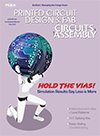Features Articles

Quality is found in the design as well as the process.
Solder defects are inevitable. Reducing their risk is mandatory, especially if you’re aiming to make money as a result of operations. Machines are certainly not “almost human,” but they do go through seasonal changes and have moods. Without proper upkeep, they fall into disrepair. The goal in assembly is to dial in the thermal profile of the soldering equipment to minimize solder defects.
Footprint model accuracy is an enabler, but that work can be undone by improper routing and copper-flooding techniques. Placement too near the edge of the board where the temperature fluctuates to a greater degree can decrease yields through the soldering process. Tombstoning is one thing to watch for, but other dangers are present on the frontier.
The Goldilocks zone. Another defect can occur when one lead of a component is close to the edge while the other is farther inward. Wirewound resistors and inductors can become open circuits or more insidiously latent defects, where the wire pulls away from the lead only when there is a temperature rise or a mechanical shock to the system. Ceramic caps can actually crack when one lead solidifies before the other one.
To continue reading, please log in or register using the link in the upper right corner of the page.

As-supplied component residues are often the culprit.
This month we look at dewetting on the surface of solder mask or components in manufacture.
FIGURES 1 and 2 show the impact of dewetting on the surface of plastic components in conformal coating. Figure 2 illustrates dewetting on solder mask. In both cases if the coating does not cover all the critical areas of the assembly, it must be reworked. It is up to the quality and design departments to agree what level, if any, of dewetting is acceptable to the product and the customer, rather than just quoting a standard. In some cases, the position or level of the problem may not affect the product operation or reliability.
To continue reading, please log in or register using the link in the upper right corner of the page.

Or even mildly irritated. So watch those catchphrases.
As we move into 2021, I resolve to renew my approach to doing business, call things as they really are, and exile all my peeves into permanent residence, where they belong, in their appropriate circle of Hell, apropos Dante Alighieri.
That’s right: we’re talking Inferno.
Flames have consequences.
Nine circles. Nine gripes. All therapy.
In ascending order of severity.
To continue reading, please log in or register using the link in the upper right corner of the page.

Needed: Methods to best predict and adjust to demand spikes.
Any supply-chain management executive will likely tell you that 2021 is 2020 on steroids. Reason: While 2020 had supply-chain disruption, the worst part of that disruption was followed by drops in customer demand due to Covid-19-related lockdowns, so the situation never worsened beyond spot shortages or transportation delays. This year, pent-up consumer demand combined with historic low interest rates supporting consumer spending is spiking product demand in multiple industries as consumers make purchases they delayed in 2020. 5G infrastructure is rolling out, demand has increased for electric vehicles, which have substantially more electronic components per car, and Covid-19 continues to drive higher medical equipment production. As a result, demand variations are changing schedules weekly. At the same time, constraints developing in the materials market are driving higher prices and longer lead-times. Transportation and freight resources are stretched, and pricing and lead-times are increasing. Covid-19 continues to cause some level of disruption as hot zones develop around the world. In short, 2021 will be a year where multiple variables are constantly in flux.
To continue reading, please log in or register using the link in the upper right corner of the page.

For real-time and predictive interventions, smart patches are in style.
For many of us in the technology sector, markets for high-tech products have remained resilient in the face of the effects of the pandemic. Despite lockdowns and restrictions, businesses are finding innovative ways to continue operating safely. Indeed, some seem to be thriving.
Gartner predicts the wearables market will grow 18% in 2021, reaching $81.5 billion. Ear-worn devices represent almost 50% of this market, with the current strong sales attributed to the WFH trend – as people upgrade from standard headphones for video conferencing – and the latest smartphones that have no 3.5mm jack.
Gartner notes, however, the increasing contribution of smart patches in the wearables space, rising to third in importance as sales of wristbands decline. This technology has ample potential to realize innovations in fields such as medicine and wellbeing that are so far undiscovered.
Bringing together multiple exciting technologies, such as flexible electronic materials, miniature sensors capable of detecting movement and various biomarkers, and micro-needles to deliver medicines when needed, smart patches are already changing healthcare. Conditions such as diabetes can be managed by detecting glucose levels in sweat on the surface of the skin and automatically injecting the appropriate quantity of insulin through an array of micro-needles. Researchers in the UK have considered similar patches to administer coronavirus vaccines.
To continue reading, please log in or register using the link in the upper right corner of the page.

Solving the age-old dilemma between design and manufacturing.
Developing a new product or process – or even aggressively refining them – is a juggle of “wants” and “needs.” As manufacturers in an industry that constantly pushes the envelopes of performance, real estate, and – yes! – cost, our industry is precisely where the rubber meets the road in reconciling needs and wants.
Manufacturing is a curious profession that often relies on older equipment, processes and employee skills to produce cutting-edge “new” products. The catalyst is, of course, people: people who design and people who take those designs and make functioning product. As smart, talented, dedicated and thoughtful as these people may be, however, they often fail to communicate the needs vs. the wants.
Indeed, it can be hard to know what’s on the other side of the hill.
To continue reading, please log in or register using the link in the upper right corner of the page.
Press Releases
- Robert C. Donovan Joins DISTRON CORPORATION, Marking the Third Generation in Family Leadership
- Incap UK Invests in SMT Technology as Part of Long-Term Operational Development
- Evolve Manufacturing Celebrates 100 Years of Combined Leadership in Medical Device Manufacturing; Noreen King Comments
- STI Celebrates Christy Hill’s 20 Years of Dedicated Service; David Raby Comments


